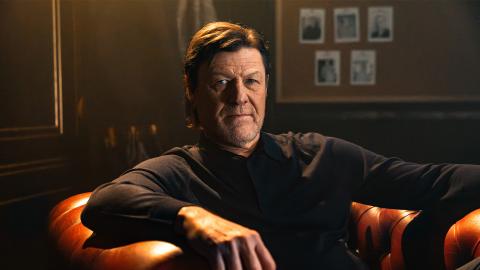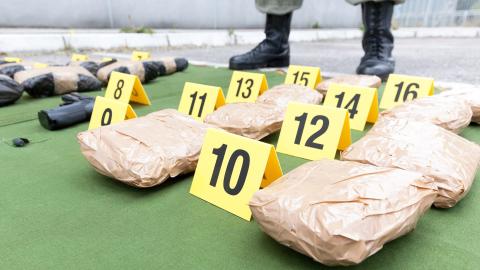Stalin’s daughter: the Cold War’s most famous defector
The date was 21 April 1967. A Swissair plane had touched down at JFK Airport in New York and a scrum of reporters was jostling for position as the doors on the aircraft began to open. A 41-year-old woman stepped off the plane and went to greet them. ‘Hello there, everybody! I am very happy to be here.’ Svetlana Alliluyeva, the only daughter of Soviet dictator Josef Stalin, had just become the Cold War’s most famous defector.
At a press conference a short while later Svetlana denounced the Soviet regime, publicly burnt her Soviet passport, declared her father a ‘moral and spiritual monster’ and finally felt ‘able to fly out free, like a bird.’ Although Svetlana had escaped her homeland, she would go on to spend a lifetime trying to cast aside the shadow of her father. ‘Wherever I go,’ she said, ‘here, or Switzerland, or India, or wherever. Australia. Some island. I will always be a political prisoner of my father’s name.’ This is the story of ‘the little princess of the Kremlin’.
Stalin’s only daughter came into this world on 28 February, 1926. Born Svetlana Stalina, she was Stalin’s youngest and favourite child. Although she was mainly brought up by a nanny, on the occasions in which she did see her father he was nothing but doting in the early years. Nicknaming her his ‘little sparrow’, Stalin would lavish her with gifts, show her Hollywood movies, write her affectionate letters and shower her with kisses as she sat on his lap. It was a gentle side of the dictator that few else would ever see.
Being the favoured daughter of one of the world’s most powerful men, Svetlana’s early youth was idyllic. That all changed when she was six years old. Her mother, Nadezhda Alliluyeva, had become tired of Stalin’s philandering and coldness towards her and after a public spat with her husband she shot herself in the heart. Young Svetlana was told she had died from acute appendicitis. She wouldn’t learn the truth for another 10 years.
The life of a man depended entirely on a word from my father
As she grew older, Svetlana’s eyes began to open to the world around her under her father’s regime. During the Great Purge of the 1930s, a few of her beloved aunts and uncles began to disappear along with other family members. As Svetlana grew more independent her relationship with her father became more fractious and over time less affectionate.
She soon understood the power that he yielded when a school friend’s father disappeared. The mother of the man had given her child a note to pass on to Svetlana and asked that she could give it to her father. She did and in doing so found herself on the receiving end of Stalin’s fury. He told her not to do it again and that the NKVD (Soviet Secret Police) were never wrong. She realised at that moment that ‘The life of a man depended entirely on a word from my father.’ She would witness this even closer to home in an event she described as one of two occasions that her father ‘broke’ her life.
When she was 16 years old she fell in love with a 38-year-old Jewish filmmaker named Aleksei Kapler. When Stalin found out about the relationship he slapped Svetlana twice across the face before having her boyfriend sentenced to 10 years in a labour camp in the Arctic Circle.
Something in me was destroyed. I was no longer able to obey the word and will of my father
That same year Svetlana was reading an English newspaper to practice her language skills and read an article that mentioned her mother’s suicide. It was a defining moment in her life which she’d later go on to mention in her memoirs. ‘The whole thing nearly drove me out of my mind. Something in me was destroyed. I was no longer able to obey the word and will of my father and defer to his opinions without question.’
The second time her father ‘broke’ her life was when he prevented her from studying literature at Moscow University, scoffing at the thought of his daughter becoming a bohemian, insisting instead that she study history and become ‘an educated Marxist.’
At the age of 17, she accepted a marriage proposal from a fellow university student called Grigory Morozov. Like her previous boyfriend, he was also Jewish. This time, however, Svetlana got her wish and was allowed to be with the man she loved, albeit begrudgingly with Stalin telling her, ‘Go and marry him, but I will never meet your Jew.’
Svetlana and Grigory had a child together, a boy named Iosif who was born in 1945, the same year WWII ended. The marriage did not last though and within a couple of years, they were divorced. A second marriage followed shortly after in 1949, this time to someone Stalin approved of, the son of his right-hand man and close confidant Andrei Zhdanov. In 1950, Svetlana gave birth to her second child, a daughter named Yekaterina. Just like her first marriage though, this one was shortly dissolved after the birth of the child.
The death agony was horrible. He literally choked to death as we watched,
By this time Svetlana was now working as a teacher and a literary translator and in March 1953, her father would suffer a stroke and die a painfully slow death that Svetlana would witness first hand. She wrote in her memoirs, ‘God grants an easy death only to the just’, before going on to describe her father’s last agonising moments, ‘The death agony was horrible. He literally choked to death as we watched. At what seemed like the very last moment he suddenly opened his eyes and cast a glance over everyone in the room. It was a terrible glance, insane or perhaps angry, and full of the fear of death.’
In the coming years, Svetlana wanted to distance herself from her past and changed her surname to her mother’s maiden name, Alliluyeva. Another marriage and divorce came in the early 60s along with the death of her last surviving brother from alcoholism. Her other brother was already dead, having been killed in a German concentration camp during WWII, after Stalin had refused to secure his release and exchange him for a German Field Marshal.
Whilst recovering from having her tonsils out, Svetlana met Brajesh Singh at Moscow hospital in 1963. Singh was a communist who had flown from India to receive medical treatment. The two fell in love and wished to marry but the Soviet state would not allow it. After just a few years of being together, Singh passed away from respiratory problems in 1966. Svetlana demanded she be allowed to travel to India to scatter his ashes into the sacred Ganges River and the Kremlin reluctantly agreed.
It was in India that Svetlanta decided she’d had enough of the claustrophobic world that she’d had to endure in Russia declaring, ‘India had a really tremendous impact on me—on my thinking, on my everything.’
On 6 March 1967, carrying just a small suitcase and with only two days left before she was due to return to Moscow, Svetlana spontaneously decided to defect to the U.S. Sneaking over to the American embassy she put in a formal request for political asylum. The American diplomat who met her was at first unsure whether she was who she said she was, mainly due to the fact that no one in the West, not even the CIA, knew that Stalin had a daughter.
In the end, embassy officials decided to help her and put her on the first flight out of India. That night she flew to Rome and was then later taken on to Geneva. By the time the Soviets realised she was missing it was too late. Fearing Svetlana would become a political pawn in the Cold War, assassination plans were apparently drawn up but never enacted for fear that any attempt on her life would be too easily linked back to the Kremlin.
After weeks of deliberation, President Lyndon B. Johnson agreed to allow Svetlana to be brought to the U.S. on humanitarian grounds, although he requested she arrive with little fanfare, as relations between the two superpowers was at that point starting to cool down. His request was clearly ignored as her plane touched down in front of a crowd of gathering journalists.
Back in Moscow, Svetlana had left behind her two children who were then aged 21 and 16. Although she wrote them a lengthy letter upon arriving in the U.S., contact with them soon disappeared. The Kremlin declared Svetlana a traitor and a ‘tool of the CIA.’ She would later be stripped of her Soviet citizenship.
Although Svetlana always denounced her father’s regime, she never believed he acted alone and felt that ‘many other people in our Politburo were responsible for terrible things for which only he was accused.’ One person in particular she believed caused a lot of the bloodshed that was attributed to her father was Stalin’s secret police chief Lavrentiy Beria.
At first, it seemed that Svetlana had embraced her new life in America. With high public interest in her story she published two memoirs about her time in Russia and her defection to the West. Her first book, Twenty Letters to a Friend was an international best seller. Svetlana soon found herself a millionaire, an American citizen and a wife of an American man, Wesley Peters who was an associate of famed architect Frank Lloyd Wright. In 1970, she changed her name again, this time to the more American sounding Lana Peters.
Like her previous three marriages, her time with Wesley didn’t last long but it did provide Svetlana with her third child, a daughter called Olga who was born in May 1971.
In the following years a series of bad financial decisions, along with charitable donations, left Svetlana almost broke. She became restless and began to constantly move around the country, never putting down roots for very long. According to her daughter, ‘Mom used to move around every year, sometimes twice in a year. She always had to be in a new place by November, when her mother died.’
By the early 80s Svetlana decided to move to England, in part to find a better school for Olga. It was there that her son back in Russia got in contact with her and in 1984 she and Olga moved back to the Motherland. With Stalin’s legacy undergoing somewhat of a rehabilitation, Soviet officials heralded her arrival home and declared it an even greater political coup than the time she had jumped ship. Svetlana herself denounced the U.S., stating that she’d not known ‘one single day’ of freedom in the West and that she’d been a pet of the CIA.
Life back in Soviet Russia was not what she had expected though. Contact with her son began to fade once again, her oldest daughter there refused to meet her and everywhere Svetlana and Olga went brought unwanted attention. ‘My greatest burden lay in the need of everyone to tell me “what a great man” my father was: some accompanied the words with tears, others with hugs and kisses.’
Within a year Svetlana requested to return to the U.S. and Soviet authorities granted her the wish on the basis that she ‘behave herself. By 1986, she and Olga once again found themselves back in the States and she quickly disavowed her previous anti-American statements. Although she would never find the normal life she so desperately craved, her life back in the U.S. was now at least away from public view.
In 2008, her son Iosif died of a heart attack and in 2011 Svetlana herself passed away from colon cancer in a nursing home in Wisconsin. She was 85 years old. ‘You can’t regret your fate,’ Svetlana once said, ‘although I do regret my mother didn’t marry a carpenter.’
















